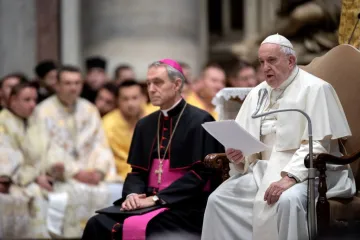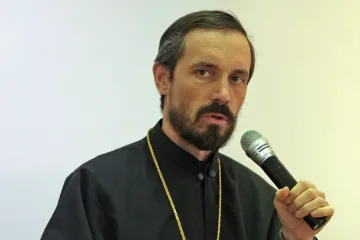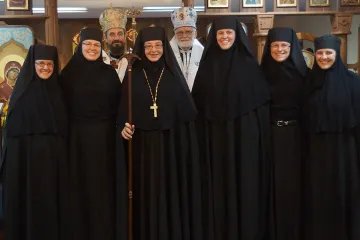Rome Newsroom, Jul 19, 2021 / 12:15 pm
When Pope Francis travels to Slovakia in September, one of his stops will be Prešov. Located in the east, the city was part of the Kingdom of Hungary until the mid-20th century, and is home to many of the country’s more than 200,000 Ruthenian Byzantine Catholics.
While the official schedule of the visit has not yet been published, according to one source Pope Francis may on Sept. 14 celebrate a Divine Liturgy in the Byzantine rite while he is in Prešov.
The Ruthenian Catholic Church is one of 23 Eastern Catholic Churches in communion with the Holy See.
In April, Byzantine Catholics in Slovakia and around the world celebrated the 375th anniversary of the Union of Uzhhorod, an agreement which brought the Ruthenian Orthodox Church into communion with the pope after nearly six centuries of schism.
In 1996, St. John Paul II wrote a letter for the 350th anniversary of the Union of Uzhhorod.
He said the union “constitutes an important moment in the history of a Church which by that act re-established full union with the Bishop of Rome. It is therefore very understandable that I too join in the thanksgiving to God of all those who rejoice in the memory of that significant event.”
“The facts themselves are well known,” he said: “on 24 April 1646, in the church of the Castle of Uzhorod, 63 Byzantine-rite priests of the Eparchy of Mukacheve, led by the Basilian monk Parthenius Petrovyc and in the presence of the Bishop of Eger, George Jakusics, were received into full communion with the See of Peter.”
Daniel Černý, a Slovak historian and Byzantine rite Catholic, spoke to CNA about the significance of the Union of Uzhhorod, which was signed by 63 Ruthenian clergy in 1646.
“We have to locate this union also in the general picture of the time: this is the mid-17th century, when there was a lot of turmoil in the history of this region,” he said, explaining that there were civil wars, feudal uprisings, and clashes between Protestants and Catholics, as represented by the Habsburgs.
Landlords were putting “huge pressure” on Eastern Orthodox Christians to convert to Protestantism, especially Calvinism, Černý said.
He said the Union of Brest, in 1596, showed Ruthenian Orthodox Christians it was possible to “preserve your rites, your traditions and still be part of the Catholic Church,” which was then supported by the government, protected from oppression, and gave equal social status to clergy. The Union of Brest united Orthodox Christians in the Polish-Lithuanian Commonwealth with the Holy See, leading to what is now the Ukrainian Greek Catholic Church.
The Union of Uzhhorod therefore “contributed to an overall improvement not only of the Church structure but also of the quality of religious life” for Eastern rite Catholics in the area, Černý stated.
St. John Paul II said: “The joyful commemoration of the Union of Uzhorod provides a favourable opportunity for giving thanks to the Lord who has dried the tears of his children at the end of a tragic period of severe persecution.”
The Lord “has sustained them in such a difficult period of their history, enabling them to preserve the wealth of their Eastern tradition and to remain at the same time in full communion with the Bishop of Rome,” he continued.
“They thus bear witness to that universality which makes the Church a diverse reality able to embrace, under the charism of Peter, that legitimate variety of traditions and rites which, far from harming her unity, shows forth all her richness and splendour.”
During the anniversary of the union in April, celebrations took place at the Ruthenian Eparchy of Mukachevo, which was formed following the Union of Uzhhorod, and is located in what is now western Ukraine.
(Story continues below)
Since the Union of Uzhhorod, eparchies have been created to shepherd Ruthenian Catholics wherever they live, including the Metropolitan Eparchy of Pittsburgh and its three suffragan eparchies in the United States, and the Metropolitan Eparchy of Prešov in Slovakia with its suffragans, as well as a Slovakian eparchy in Canada.
“These are all the spiritual daughters of the Eparchy of Mukachevo, and all of the faithful and the clergy of these ecclesiastical structures derive, or are really the heirs, of what was then the Union of Uzhhorod,” the historian said.
He said Pope Francis’ trip will be a good opportunity for him to visit the eastern, and poorer, part of Slovakia.
Černý said like many places in the world, the coronavirus pandemic has isolated people and exposed deeper divisions in society, but the pope’s visit is widely looked forward to.
“It seems like all Slovakia is looking forward to this visit,” he said.
Most of Slovakia’s population is Catholic, but the country’s ruling political party leans liberal, Černý explained. Yet, enthusiasm about the pope’s visit seems to unite both the practicing Catholics and those who are not churchgoers.
“I really hope that [Pope Francis] will bring the calmness, the peace to the faithful,” he said.
“This time reveals how deep the divisions between people get. Especially during the pandemic situation when many people lost their social contact and became much more secluded…”
He said there is a painful division showing up in Slovak society. “And really what we need to focus on is bringing back the peace.”
“Of course peace can be achieved only by Christ. So that’s probably what the people are expecting from the visit of the pope – [for him] to be the messenger of hope and peace,” Černý stated.






